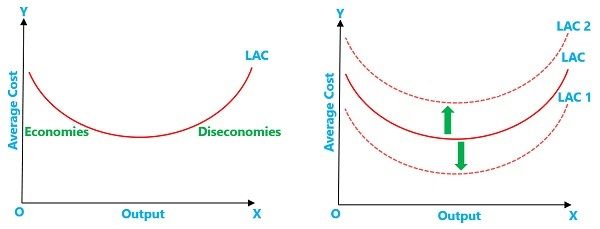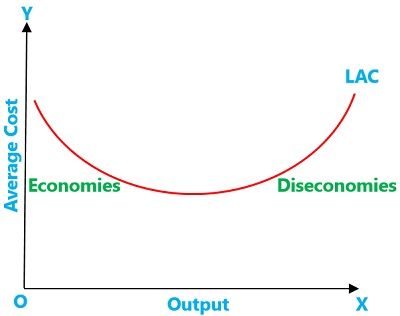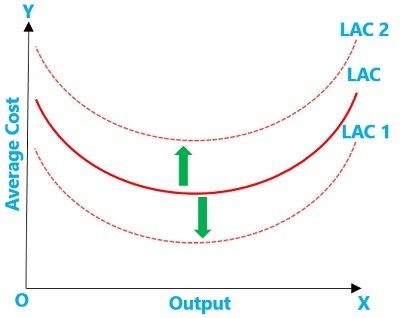 Internal Economies of scale is a result of endogenous determinants, i.e. the reasons which are internal to the firm. On the contrary, External economies of scale occur on account of exogenous determinants, i.e. the reasons which are external to the firm.
Internal Economies of scale is a result of endogenous determinants, i.e. the reasons which are internal to the firm. On the contrary, External economies of scale occur on account of exogenous determinants, i.e. the reasons which are external to the firm.
The Long-run Average Cost (LAC) curve has a U-shape, due to the returns to scale, i.e. economies and diseconomies of scale. Economies of scale imply the corresponding savings in the cost of production achieved by the rise in the level of output or size of the plant. Here, the savings in cost means a reduction in relative terms and not in total cost in absolute, i.e. the average cost of output will be reduced.
However, if the scale of production exceeds a specified limit, resulting in diseconomies of scale. Economies and Diseconomies of scale are classified as Internal and External Economies and Diseconomies of Scale. In this article, we are going to discuss the differences between internal and external economies of scale.
Content: Internal Vs External Economies of Scale
Comparison Chart
| Basis for Comparison | Internal Economies of Scale | External Economies of Scale |
|---|---|---|
| Meaning | Internal economies of scale are those that arise on account of an increase in the scale of production and plant-size. | External economies of scale are those that arise outside the entity and accrue to the growing entities. |
| Long run average cost curve | Falls due to the expansion in output by the firm up to a certain extent. | Shifts downward due to the expansion in size of the industry or economy as a whole up to a certain extent. |
| Reflected as | Movement along the LAC curve. | Shift of the LAC curve. |
Definition of Internal Economies of Scale
Internal economies of scale are the real economies which accrue to the firm because of its internal situation, i.e. they are limited to the firm only and are independent of the moves of other entities in the industry. It is mainly concerned with the augmentation of the level of output or the plant size of the entity. The primary source of internal economies of scale are discussed below:
- Economies in Production: Economies in Production can be achieved by:
- Technological Advantages: When a firm increases its level of production, it provides the scope of technological advancements, i.e. the firm can use superior and specialised technology for producing the output which facilitates in designing the entire process of production into a single integrated unit, which increase the total output till an optimum size is reached.
Further, the firm can use by-products, for additional earnings. As well as, the firm can also go for forward and backward integration, to expand the processes and market of the firm. - Advantages of Division of Labor and Specialisation: When a firm increases its production volume, more and more manpower of diversifying skills, qualification and experience, are hired. The firm can implement division of labour, to attain specialisation of the workforce, by dividing them according to their expertise.
- Technological Advantages: When a firm increases its level of production, it provides the scope of technological advancements, i.e. the firm can use superior and specialised technology for producing the output which facilitates in designing the entire process of production into a single integrated unit, which increase the total output till an optimum size is reached.
- Managerial Economies: Managerial economies are gained by way of:
- Specialization in managerial activities, i.e. dividing the management into specialised departments, under the control of specialized managers, like production manager, sales manager, marketing manager, finance manager, human resource manager etc.
- Mechanization of managerial activities, by using advanced techniques for communication and means of transport, resulting in quick decision making and saving of time.
- Financial Economies: It is a well-known fact that larger firms have higher creditworthiness than smaller firms. Hence, they can borrow funds from the banks and the financial institution at a lower rate of interest as well as they can also raise funds by issuing equity shares.
- Marketing Economies: Economies in marketing can be gained through the purchase of raw material and other inputs in high volume from the suppliers and selling the final products on a large scale. It is concerned with:
- Economies in advertising cost
- Economies in large-scale distribution through wholesalers.
- Economies in Transport and Storage: This can be achieved by the best possible utilisation of transport and storage facilities. Large firms usually have their own means of transport and warehouses, which reduces their cost of transportation and storage.
Definition of External Economies of Scale
External Economies of Scale, or otherwise called as Pecuniary Economies are achieved by the firm, out of the expansion and growth of the industry, of which the firm is a part and also out of economy-wide development. These economies are available to various expanding firms in the form of:
- Economies of Inputs: The expansion and growth of an entire industry, may lead to the identification of new and better sources of raw material, machinery and various other capital inputs, both in terms of quality and cost. As the industry expands, the demand for raw material and capital inputs may also accelerate, which a firm can acquire at competitive prices on a large scale. This may result in reduced cost of production.
- Technological Economies: Expansion of Industry, may result in innovation and inventions. Indeed, firms will strive for gaining new technical knowledge in the quest for becoming a market leader in products and services they offer. For this purpose, the firms will use state of the art technology in production, which will save the cost.
- Human Resource Economies: If there is an expansion in the industry, the people belonging to that industry, i.e. the employees and workers are thoroughly aware of the production processes and industry practices, and have a good experience in their respective areas. So, as the industry expands, labours and employees are also developed, which increases their efficiency and productivity.
- Economies of Information: The firm can avail relevant information regarding the latest technology, a product launched, recent market developments, labour prices, etc. quickly and effortlessly from the journals and bulletins published by the government or trade associations in public interest.
- Economies of Localization: With the development of an industry in a particular region, it may result in the development of that region too. And so, there will be the improvement of transportation and communication services, easy availability of raw materials, workforce, and allied services like banking, insurance, marketing and so forth.
Key Differences Between Internal and External Economies of Scale
The difference between internal and external economies of scale are discussed in the points below:
- Internal Economies of Scale refers to the economies that are internal to the firm, accruing on account of expansion in its output. On the other hand, External Economies of Scale, as the name suggests, are the economies outside the firm and occurs to the expanding entities.
- In internal economies of scale long-run average cost curve falls due to the expansion in the level of production or plant size, up to a particular level. As against, the long run average cost curve shifts downward due to the expansion in the size of industry or economy as a whole up to a particular extent.
- The internal economies of scale can be reflected in LAC as a movement along the curve. Conversely, the external economies of scale can be indicated as a shift in LAC.
Long Run Average Cost Curve
Internal Economies of Scale
The internal economies and diseconomies of scale cause the long run average cost curve to fall and rise, making it U-shaped.
External Economies of Scale
The external economies and diseconomies of scale cause the long run average cost curve to shift downward or upward.
Conclusion
Both internal and external economies of scale accrue to the firm up to a certain level only, after then the long run average cost curve begins to rise when that level is crossed. This leads to internal and external diseconomies of scale.








Leave a Reply